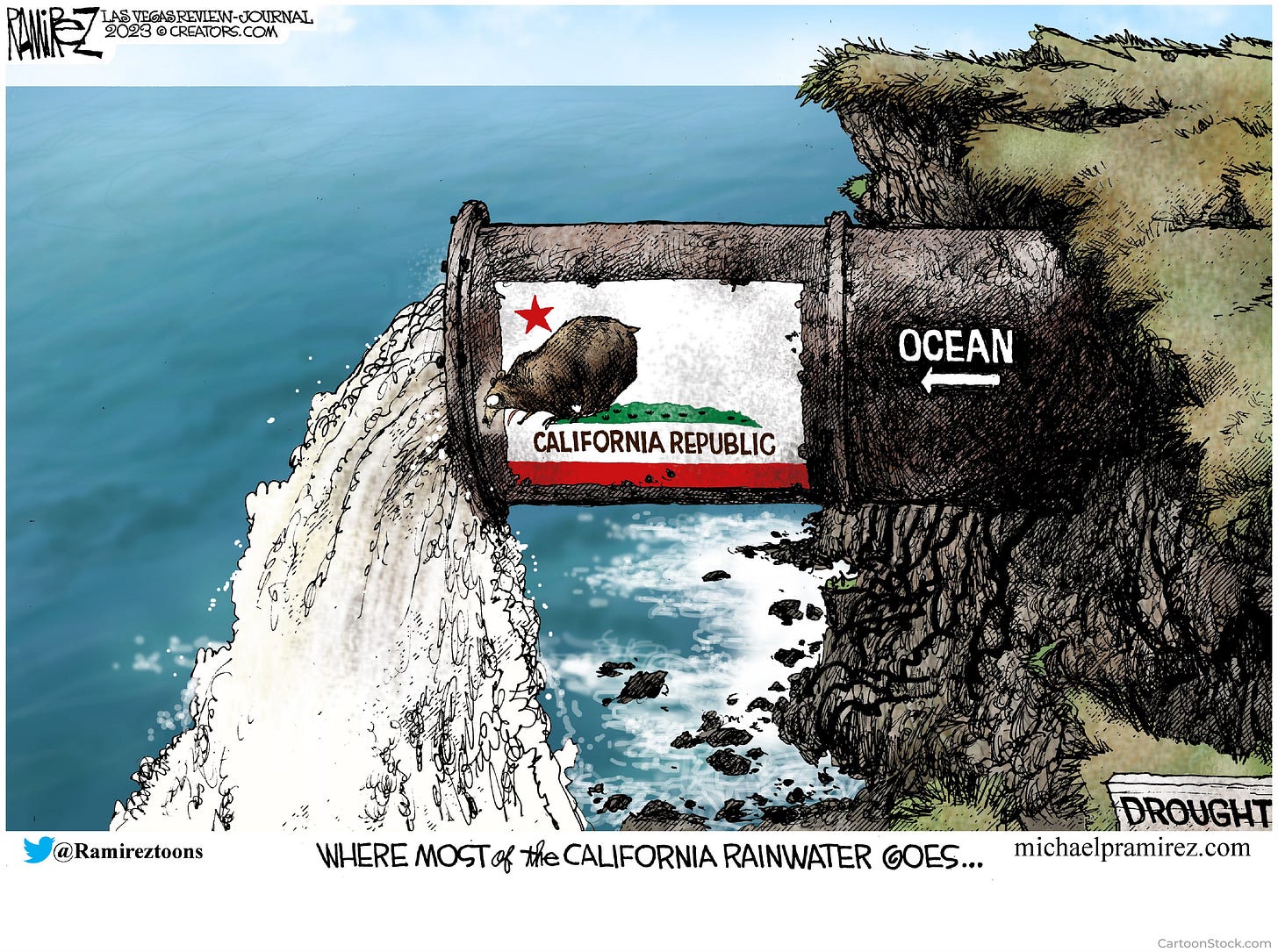The Packer recently reported (May 15, 2025) about a recent report commissioned by the CA Municipal Utilities Association and conducted by UC Davis and UC Merced concluding that, "...projected declines in the state's water supplies could result in the fallowing of up to 3 million acres of farmland, the loss of 67,000 jobs statewide and lasting damage to California's agricultural and rural communities if no action is taken.
The report focuses on trying to put a price on such water supply declines. Under a 'likely future' scenario where California's water supply declines by five million acre-feet annually, the report estimates that the state will lose $1.8 to $4.4 billion from its economy annually in direct losses, with $1.8 to $2.2 billion of that coming from direct impacts on agriculture. In a 'worse future,' where California water supply declines by 9.5 million acre feet annually, those projected economic losses jump to $7 to $14.5 billion overall and $3.7 to $11.1 billion from agriculture in direct impacts. [See the entire report at Inaction’s Economic Cost for California’s Water Supply Challenges.]
For years, I've been giving the speech that CA doesn't have a water supply shortage, we have a water supply storage shortage. In other words, our water supply shortage is almost 100% self-inflicted by the policies our state lawmakers have supported over the last 40 years in the name of “protecting” the environment.
We have done nothing about expanding California’s water supply since Governor Brown was our governor. And I am not talking about Jerry Brown, the first time he served as Governor in the 1970s, but his father, Pat Brown, who served as governor from 1959-1967. Under Governor Pat Brown, who was often referred to as the “Infrastructure Governor,” we built reservoirs, a state water project that delivers water from Lake Shasta in Northern California to Southern California, and a water delivery system intended to provide water for 25 million people. And 100% of all the water was delivered for agricultural, residential, and commercial purposes. In 1970, California had a population of 19,953,134 residents.
Population Has Doubled; Water Storage Has Not
Today, we have not built one major reservoir since New Melones Lake was constructed; we have a population of 39,529,000, and even in drought years, we divert as much as 30% of the water in the state water project to the Pacific Ocean for the purpose of “endangered species” protection. Endangered species like the Delta Smelt, which is a tiny, nearly transparent fish native to California's San Francisco estuary. We have rediverted this water to the Pacific Ocean, notwithstanding that there is significant scientific data that suggests water flow is far less a significant factor for the survivability of the Delta Smelt than raises in water temperature that have been caused by wastewater treatment plant discharges into the Delta. Notwithstanding that there are now twice as many people, no new major reservoirs being built, and a diversion of up to 30% of the state water projects' water going into the Pacific Ocean, through incredible conservation measures by the state's residents, businesses, and especially agriculture, we have managed to marginally get by.
But, as I have warned for decades and as this study underscores, that is all about to change dramatically if we don't change our water storage policies. After decades of the proponents of more water storage fighting the environmental interests that oppose new storage, we won one battle getting the decision to build the Sites Reservoir. To get that approval, we had to sign off on a water bond with billions that did nothing for storage. But that was the trade-off to get approval for Sites, which is scheduled to be completed in 2026. When full, it will provide 1.5 million acre feet of water. But that is only 1.5 million acre feet, which will provide water to between 3 to 5 million people, leaving us a huge shortfall to serve at least an additional 15 million people. Other than Sites, that's it. Nothing else is planned, and nothing else will realistically be built without our lawmakers doing a complete 180 regarding building water storage.
Why Storage is So Important
As we have all witnessed, California historically has gone through drought cycles. To provide water availability insurance, you build storage that can accommodate at least twice the amount of the population the water is intended to serve. The reason you do this is so that in the wet years, the reservoirs are filled to maximum capacity, which generally equals 3-4 years of available water that would be demanded in follow-up drought years. If the Pat Brown formula were applied today, you would double the amount of storage we currently have in this state. With that doubled storage, in wet years, there would be twice as many reservoirs that would be filled as is currently possible today. If that formula were applied today, all the dire consequences predicted in the report cited above, vanish.
The question becomes: What will the Governor and our state lawmakers do now that their water doomsday scenario is staring them in the face? What we do know, without a change of policy, unless tens of millions of people leave the state, which isn't going to happen, the warnings in the report referenced above will become reality. This is perhaps their last window of opportunity to change that inevitable outcome.
It is ironic, but we are seeing somewhat the same scenario playing out in the energy sector. The same politicians who opposed increasing water storage are the same politicians who have supported putting the oil & gas industry out of business in this state. Since passing AB 32, the Global Warming Solutions Act of 2006, the state has adopted policies that essentially prohibit new development of oil & gas production. Recently, the state legislature has gone even further in passing legislation that encourages cities and counties to eliminate existing oil & gas operations. [Note to the state legislature, we have something called the 5th Amendment of the US Constitution, which prohibits the government from taking private property without just and fair compensation. This Amendment is often referred to as 'The Taking Clause.'] And keep your eyes on our own county, Santa Barbara County, where most of the Board of Supervisors has requested the County Counsel to come back in October with pursuing this option to put out of business all the existing oil & gas operations. [The SBCTAC will be strongly opposing these efforts, which, if enacted, will certainly be legally challenged and could subject the county to billions, not millions, but billions in financial exposure in having to pay for the “taking” for the shutdown of these existing and vested operations.]
But there is a faint bit of hope. This overreach and overregulation of the oil & gas industry has caused more and more California producers to shut down. And now even Democrat lawmakers that have been supporting these policies are starting to realize the consequences of their policies and legislation, and the fact that they could lead to $8-$10 a gallon gas in this state. Pretty simple economics, as you reduce the supply, the cost goes up.
Hope on the Horizon
In a recent Utilities & Energy Committee hearing of the state legislature, Democrat Assemblyman David Alvarez said, "We have a crisis on our hand that may have been self-created by the actions taken by the state, by regulators..." Democrat Assemblyman Cottie Petrie-Norris added, "I know what climate leadership does not look like, and that is $10 gas." And on April 21, 2025, in a letter from Governor Newsom to Silva Gunda, Vice-Chair of the CA Energy Commission, the Governor wrote, "I write to direct you to redouble the State's efforts to work closely with the refiners on short and long term planning, including through high-level immediate engagement, to help ensure that Californians continue to have access to a safe, affordable, and reliable supply of transportation fuels..." The Governor added, "Building on that engagement and the California Energy Commission's (CEC) Transportation Fuels Assessment, I direct you to recommend by July 1, and changes in the State's approach that are needed to ensure adequate supply..." We all should be able to see that report shortly.
There is hope when it comes to energy, as it appears that some of those who have created this problem have awoken to the doomsday tomorrow that will happen if they don't change course. Unfortunately, thus far, we haven't seen the same change of heart when it comes to water. For energy, there is existing infrastructure in place that, if incentivized, could be back in production in a short period of time. For water, that is not the case. Building a new major reservoir takes a minimum of 10 years from the start of the process to the water flowing.
Elections do have consequences, and past elections have led to unreasonable, irrational, and outrageous energy and water policies, putting us in the quandary we now face. The policymakers can change the predicted outcomes, but they must act fast.
Unfortunately, given past history, the smart money is not on that occurring.
Mike Stoker currently serves as President & CEO of the Santa Barbara County Taxpayer Advocacy Center. Stoker is a land use, environmental, and business law attorney. He has previously served on the Santa Barbara County Board of Supervisors, was Chairman of the CA Agricultural Labor Relations Board, Majority Counsel to Congress, CA Deputy Secretary of State and served as the Southwest Administrator of the US EPA overseeing a population of 75 million people.








More Chicken Little, the sky is falling lunacy from the left. Let’s try to understand the party stance; we have to limit/eliminate dams and reservoirs in order to save the Smelt, but destroy our economy? We have to allow our forests to become overgrown to their natural state in order to save our environment, but burn up our homes in the process? We have to close our oil refineries in order to save our planet, but go bankrupt in the process?
This is what the left does, they use a bizarre matrix to make their case, ignoring the need for humans to prosper despite the “environment.”
This is why companies such as Standard Oil are leaving California and taking jobs from our economy, because of nutty, unhinged policies, perpetrated by white, liberal elites on the rest of us.
In order to meet future demands, the State of California must change course, allowing for forests to be free from becoming ticketing time bombs, building new, advanced refineries, building nuclear power plants, building or renovating desalination water facilities and upgrading or building new, advanced water storage infrastructure.
Once again, the issue continues to proceed with a blind spot in the conversations about California's water. The commercial salmon industry recently was valued at $1.5 billion...that's billion with a B. For the last 2 years, and probably next year as well, the fishery has been closed. Not only does the fishery face closures, extinction is also becoming a very real possibility This doesn't even consider the economic value of the recreational sector. Water released to the Pacific is NOT wasted water. Additionally, since the earliest contracts with the State, native fish (salmon) have senior rights. Very shortsighted article.